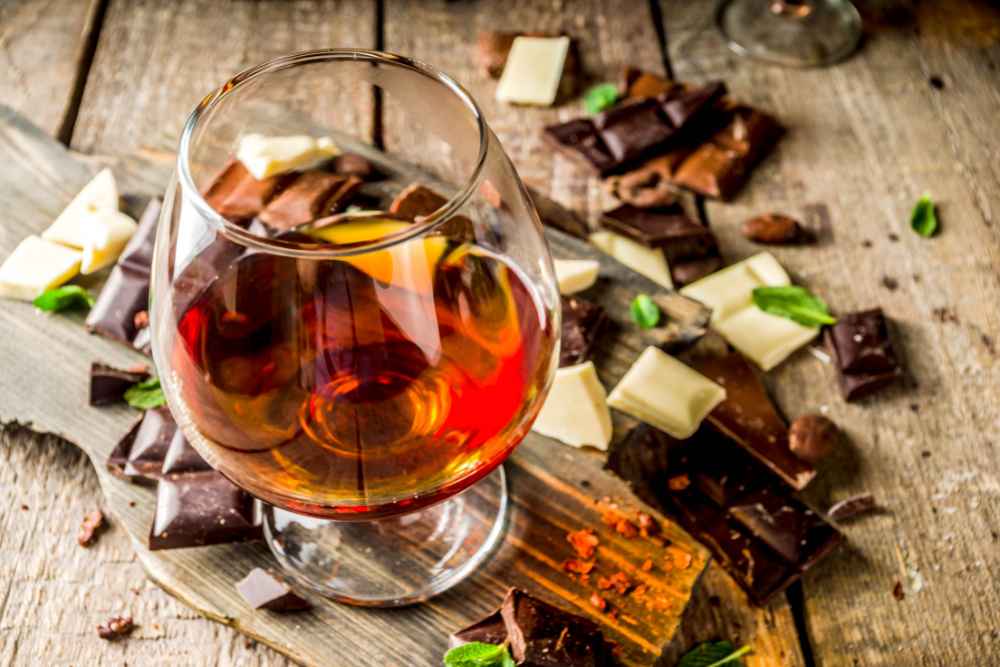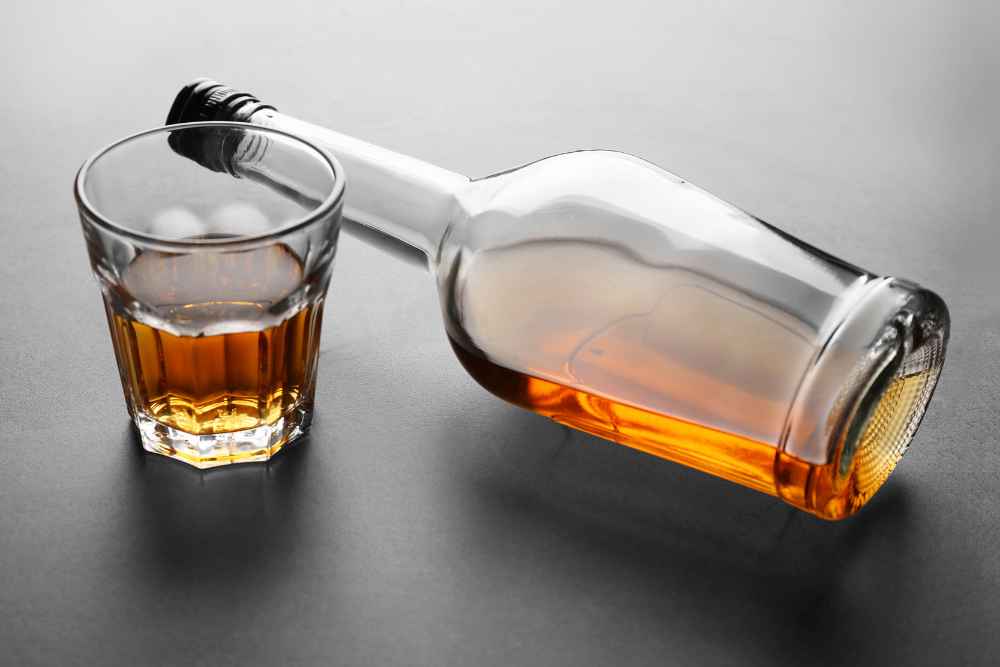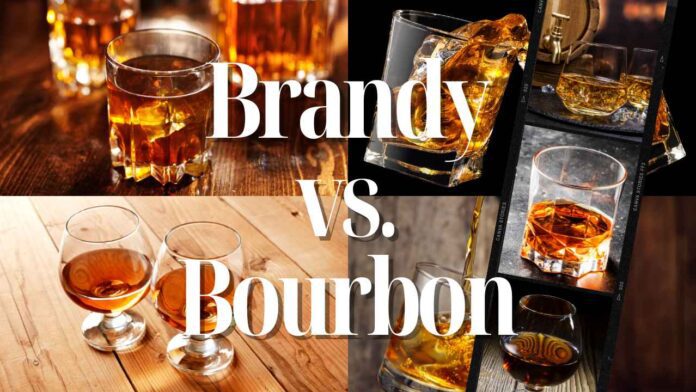This page may contain affiliate links. Please see our Disclaimer for more information. Always drink responsibly and adhere to your local legal drinking age.
Welcome to the fascinating world of spirits, where today we’ll explore the differences between two popular libations: brandy and bourbon.
Although they may seem similar at first glance, these distinct beverages offer unique flavors, pairings, and experiences for your palate.
Key Takeaways:
- Brandy is made from distilled wine or fermented fruit mash, while bourbon is American whiskey primarily made from corn.
- Both brandy and bourbon are aged in oak barrels to enhance their flavor profiles, but the types of wood used and the duration of aging differ between the two spirits.
- Brandy tends to have fruity notes with hints of vanilla and caramel, while bourbon tastes sweet due to its high corn content and smoky flavors imparted by charred oak barrels.
- When pairing these spirits with food, brandy pairs well with cheese, chocolate, fruit-based desserts, and meat dishes. Bourbon complements spicy and smoky foods and sweet and savory plates such as glazed ham or dark chocolate desserts.
What Are Brandy And Bourbon?

Brandy and bourbon are distilled spirits with distinct characteristics and production processes.
Definition And Production Process Of Brandy And Bourbon
The world of spirits can be pretty fascinating, particularly when understanding the differences between two popular choices: brandy and bourbon. Both have rich histories and complex production processes that create unique flavor profiles.
Brandy is made by distilling wine or fermented fruit mash, with grapes being the most common fruit used in its creation. After fermentation, the resulting liquid undergoes distillation – often through copper pot stills – which separates alcohol from water and other components, creating a more concentrated spirit.
The distilled product is then aged in oak barrels to develop its signature flavors.
Conversely, Bourbon is a type of American whiskey made primarily from corn – at least 51% per legal requirements – though it may also contain wheat, rye, barley, or malted grains as part of its grain mash bill.
This mixture goes through a fermentation process like beer brewing before being distilled into a clear spirit called “white dog.” Unlike brandy’s copper pot stills preference, bourbon production typically employs a column distillation method for continuous operation, contributing efficiency gains during this stage and making supervision easier.
Next step, the white dog gets transferred into new charred oak barrels for aging, picking up color and flavor characteristics from tannins found within wood fibers until becoming ‘bourbon’ as we know it today.
Key Ingredients And Flavor Profiles
The core ingredients used in the production of brandy and bourbon vary significantly, ultimately resulting in their distinct flavor profiles. Brandy is derived from distilled wine or fermented fruit mash, using grapes as the primary ingredient.
Its smooth, fruity taste can be attributed to this grape-based foundation. It can also be made from other fruit; apple brandy is also famous besides grape brandy.
On the other hand, bourbon’s key ingredient is corn – specifically, at least 51% corn must be present within its grain mash mixture. Other grains, such as rye and barley, may be included to create a well-rounded mix.
This high percentage of corn lends bourbon its characteristic sweetness accompanied by rich caramel and vanilla flavors due to its aging process in charred oak barrels.
The Key Differences Between Brandy And Bourbon
Discover the unique differences between brandy and bourbon, from the ingredients used to the distillation process and aging techniques.
Ingredients
One of the primary differences between brandy and bourbon lies in their ingredients. Brandy is made by distilling wine, which typically comes from grapes, but other fruits like apples, pears, or cherries may also be used to create unique flavor profiles.
The choice of ingredients significantly impacts the taste and aroma of these two spirits. For example, grape-based brandies often boast fruity and floral notes with hints of sweetness borrowed from their wine origins.
In contrast, bourbons showcase more robust flavors due to their high corn content—caramelized sugar tones mixed with charred oak nuances imparted by aging in American Oak barrels.
Distillation Process
During distillation, brandy and bourbon use a similar method to purify and increase their alcohol content. However, they differ slightly in terms of how often they are distilled.
Brandy is usually double-distilled in copper pot stills, while bourbon undergoes a single distillation process before being aged in oak barrels to enhance its flavor profile.
The choice of the oak barrel also impacts the final taste of each drink; bourbon barrels are charred to create a smoky flavor, whereas brandy may use different types of oak for varied nuances.
Aging Process And Barrel Types
The aging process and barrel types play a crucial role in the critical differences between Brandy and Bourbon. Both liquors are aged for at least two years, but Brandy tends to age longer than Bourbon.
The type of wood barrel used also affects the flavor profile of each liquor. For instance, Brandy that ages in French oak barrels for two years or more will have more oak than un-aged Brandy, giving it a rich vanilla flavor with notes of spice and fruit.
On the other hand, Bourbon must be aged in new American oak barrels that impart flavors of caramel, vanilla, and charred wood into the whiskey.
Flavor And Aroma Profiles
Brandy and bourbon have distinct flavor and aroma profiles. Brandy is typically characterized by its sweet, fruity notes with hints of apricot, peach, cherry, or apple from the fruit used in production. At the same time, bourbon is known for its bold, smoky flavor profile with notes of vanilla and caramel from the oak barrels it’s aged in.
The aging process also significantly affects both drinks’ taste profiles. Brandy tends to be smoother since it’s usually aged longer than bourbon; however, some premium bourbons are aged for extended periods to achieve similar smoothness.
Tasting Brandy And Bourbon
To properly taste brandy and bourbon, it’s essential to understand their distinct flavor profiles – brandy tends to have fruity notes with hints of vanilla and caramel. At the same time, its sweetness and oaky finish characterize bourbon.
Brandy’s Flavor Profile And Tasting Notes
Brandy is a versatile spirit with a complex flavor profile that makes it suitable for sipping and mixing. Here are some of the typical tasting notes you might find in different types of brandy:
1. Fruit: Brandy’s core ingredient is often fruit, such as grapes, apples, or pears, which gives it a fruity flavor profile. The fruitiness can range from subtle to distinct, depending on the variety.
2. Oak: The aging process takes place in oak barrels, which impart flavors such as vanilla, caramel and spices like clove and cinnamon.
3. Nutty: Some brandies exhibit nutty flavors like almonds or hazelnuts due to natural oils and enzymes in the fruit.
4. Floral: Brandies from specific grapes can have floral notes like rose or violet, while others may hint at honey or grassiness.
5. Sweetness: Depending on their age and production method, brandies may exhibit variations in sweetness. Some may have just a sweetness, while others may be pretty syrupy.
Overall, brandy offers complex aromas and nuanced flavors that lend themselves well to being served neat or in classic cocktails like the Sidecar or Brandy Alexander.
Bourbon’s Flavor Profile And Tasting Notes
Bourbon has a unique flavor profile characterized by its sweet, smooth, and slightly smoky taste. Here are some of the tasting notes to look out for when enjoying a glass of bourbon:
1. Sweetness: Bourbon tastes sweet due to the corn used in the mash. The sweetness can be described as honey-like and can often be accompanied by notes of vanilla and caramel.
2. Smokiness: Bourbon can also have a slightly smoky flavor due to the charred oak barrels used during aging. This flavor can sometimes be described as woody or spicy.
3. Spice: Bourbon can taste spicy with cinnamon, nutmeg, or allspice hints. This is due to the rye or wheat used in the mash bill.
4. Fruitiness: Some bourbons may have fruity notes like cherry, apple, or orange peel.
5. Finish: The bourbon finish may vary depending on the age and type of barrels used during aging. It can range from short and sweet to long and complex with a lingering aftertaste.
When enjoying bourbon, it’s essential to take note of these flavors and how they blend to create a unique drinking experience. Whether enjoyed neat or mixed into cocktails, bourbon is a versatile spirit that offers something for every cocktail drinker’s palate!
Pairing Brandy And Bourbon

Discover the perfect pairing suggestions for brandy and bourbon with various foods and desserts to take your cocktail experience to the next level.
Brandy Pairing Suggestions
Pairing brandy with a suitable dish can genuinely enhance your dining experience. Here are some suggestions for pairing brandy with different foods:
1. Cheese: Pair a rich, nutty brandy like Armagnac with strong cheeses like Roquefort or Gorgonzola.
2. Chocolate: A sweet, fruity brandy like cherry or Kirsch pairs perfectly with dark chocolate.
3. Desserts: Pair a smooth and creamy brandy like Cognac with desserts like crème brûlée, bread pudding, or chocolate mousse.
4. Fruit: A light and fruity brandy like apricot or peach work well with fresh fruit or fruit-based desserts.
5. Meat dishes: A bold and spicy brandy such as Calvados pairs well with meat dishes with a sweet or savory element, such as pork roasted with apples.
Remember also to consider the age of the brandy when pairing it with food – younger, fruitier brandies are better suited to lighter dishes. In contrast, older, more complex ones pair well with heavier, decadent flavors.
Bourbon Pairing Suggestions
Pairing bourbon with the right food can enhance your drinking experience. Here are some suggestions for pairing bourbon with food:
1. Spicy and Smoky: Pair your bourbon with spicy and smoky foods like barbecue, smoked meats, or chipotle-spiced dishes. The bold flavors of the food complement the sweet and smoky notes in the bourbon.
2. Sweet and Savory: Pair your bourbon with dishes that balance sweet and savory flavors, such as roasted pork loin with a brown sugar rub or glazed ham. The sweetness of the dish enhances the caramel flavors in the bourbon.
3. Chocolate: Pair your bourbon with dark chocolate desserts to bring out its rich and complex flavors. The bitterness of dark chocolate complements the sweetness of the bourbon.
4. Cheese: Pair your bourbon with aged cheddar or blue cheese for a delicious combination of contrasting flavors—the sharpness of cheese balances out the sweetness in bourbon.
5. Nuts: Pair your bourbon with nuts like almonds or pecans for a tasty snack that enhances the whiskey’s nutty notes.
Always experiment and try new pairings to find what works best for you!
Drinking Brandy And Bourbon

To fully experience the complex flavors and aroma profiles of brandy and bourbon, it is recommended to serve them neat or with a few drops of water to open up their flavors.
Popular Brands And Varieties
Knowing which brands and varieties of brandy and bourbon are the most popular is helpful if you’re a cocktail drinker. Here are some options to consider:
Brandy:
– Hennessy: This cognac brand is one of the most recognizable in the world.
– Remy Martin: Another famous cognac brand known for its smooth taste.
– Torres 10: A Spanish brandy aged for a decade in oak barrels.
– E & J Gallo: An American brandy that is budget-friendly and easy to find.
Bourbon:
– Maker’s Mark: One of the most well-known bourbon brands, with a distinctive red wax seal on each bottle.
– Buffalo Trace: This Kentucky distillery produces several types of bourbon, including its flagship label Buffalo Trace Bourbon.
– Woodford Reserve: A premium bourbon that has won numerous awards for its taste and quality.
– Jim Beam: A classic bourbon that has existed since 1795 and is still popular today.
Whether you prefer brandy or bourbon, these popular brands and varieties should provide plenty of options for your next cocktail creation.
Proper Serving And Drinking Techniques
To fully appreciate the flavors and aromas of brandy and bourbon, it’s essential to know how to serve and drink them properly. Here are some tips for cocktail drinkers:
1. Serve brandy slightly below room temperature, between 60-65°F, in a tulip-shaped glass to capture its aroma.
2. Warm the glass with your hands before sipping on the brandy slowly to release the aromas.
3. Pair brandy with dark chocolate or cheese to complement its rich flavor.
4. To enhance its aroma, serve bourbon at room temperature in a traditional rocks glass or a snifter.
5. Add a small amount of water or an ice cube to dilute the alcohol content and enhance the flavors.
6. Sip on bourbon slowly and let it linger on your palate for a few seconds before swallowing.
7. Pair straight bourbon whiskey with grilled meats or solid cheeses for an exceptional tasting experience.
Properly serving and drinking brandy and bourbon can maximize their unique flavors, aromas, and complexities for a genuinely satisfying cocktail experience.
Brandy And Bourbon In Cocktails
Mixologists love using brandy and bourbon in cocktails for their unique flavors.
Classic And Modern Cocktail Recipes Using Brandy And Bourbon
Looking to mix up your next cocktail? Check out these traditional and modern recipes featuring brandy and bourbon:
1. Old Fashioned – a classic bourbon cocktail made with sugar, bitters, orange peel, and a water or club soda splash.
2. Mint Julep – another famous bourbon cocktail made with fresh mint leaves, sugar, water, and crushed ice.
3. Sidecar – a classic brandy cocktail made with Cointreau or triple sec, lemon juice, and simple syrup.
4. Whiskey Sour – a simple but delicious bourbon drink made with whiskey, lemon juice, and sugar syrup.
5. Brandy Alexander – a creamy dessert cocktail made with brandy, crème de cacao, and heavy cream.
6. Boulevardier – a modern twist on the classic Negroni that swaps gin for bourbon.
7. Manhattan – another classic cocktail that can be made with either bourbon or rye whiskey, along with sweet vermouth and bitters.
8. Sazerac – a famous New Orleans drink made initially with cognac but now often prepared using rye whiskey instead.
9. Kentucky Mule– A refreshing cocktail mixing Bourbon whiskey with lime juice and ginger beer
10. Bourbon Tea Punch- Made by steeping tea bags in cold water overnight, then adding Bourbon Whiskey, Honey Syrup, and Lemon Juice.
11. The Fitzgerald– A bubbly Cocktail that mixes Bourbon whiskey with Lemon Juice, Simple Syrup, and Champagne.
12. Brandy Crusta– This sour version mixes brandy, maraschino liqueur, Curaçao orange liqueur, Lemon juice, and Angostura Bitters.
13. French 95 – a bourbon cocktail that can also be made using brandy instead featuring lemon juice, simple syrup, and champagne.
14. Bourbon Lemonade – A refreshing summer cocktail mixing bourbon whiskey with sugar syrup, lemon juice, and soda water.
15. Brandied Cherry Sour- A fruity, refreshing drink that combines muddled Brandied Cherries with Bourbon Whiskey, Sugar Syrup, Lime Juice, and Club Soda.
Brandy Vs. Bourbon: Which One To Choose?
Choosing between brandy and bourbon ultimately boils down to personal preference and the occasion.
Factors To Consider When Choosing Between Brandy And Bourbon
Choosing brandy and bourbon can be challenging if you’re a cocktail drinker looking to try something new. Here are some factors to consider when making your decision:
1. Ingredients: Brandy is made from distilled wine, while bourbon is a type of whiskey made primarily with corn.
2. Distillation process: Brandy is typically distilled twice in copper pot stills, whereas bourbon is only distilled once.
3. Aging process and barrel types: Brandy is aged in oak barrels that may or may not be charred, while bourbon must be aged in new, charred oak barrels for at least two years.
4. Flavor and aroma profiles: Brandy tends to have a lighter, fruitier taste, while bourbon has a more complex taste that’s often described as sweet due to the use of corn.
5. Pairing suggestions: Brandy pairs well with chocolate-based desserts or rich cheeses, while bourbon complements grilled meats or spicy foods.
Remember that brandy and bourbon have unique characteristics and can be enjoyed neat or in cocktails. Consider trying different brands and varieties to find your favorite.
FAQ
1. What is the difference between brandy and bourbon?
Brandy is a spirit made from fruit, with cognac being made from grapes, while bourbon is a type of whiskey that must be made in America and contain at least 51% corn as its primary grain.
2. How do brandy and bourbon differ in taste?
Brandy has a fruity flavor with notes of vanilla, oak, and caramel, while bourbon tends to have more robust flavors of caramel, brown sugar, and spice with hints of charred oak. Both bourbon and brandy have a woody taste from aging in barrels, but brandy is made from fruit, giving it a different flavor because bourbon is made from grains.
3. Can you use brandy instead of bourbon in cocktails?
Some cocktails traditionally made with bourbon can be substituted with brandy for a different flavor profile. For example, an Old Fashioned can be made with either spirit.
4. Which one is better for cooking: brandy or bourbon?
Both spirits make excellent additions to savory dishes and desserts depending on the recipe’s requirements. Brandy pairs well with fruit-based sauces or glazes, while Bourbon’s sweetness complements grilled meat perfectly.
Conclusion
In conclusion, understanding the difference between brandy and bourbon is crucial for every cocktail drinker. While both have sweet notes and oak flavors, they are made from different ingredients and undergo other production processes.
Brandy is a distilled wine with fruity and slightly sweet notes, while bourbon is a spirit distilled from fermented corn mash with characteristically sweet characteristics.
Although they share similarities in taste production techniques, scotch, and whiskey can be confused with brandy and bourbon but are distinct spirits on their own.



















